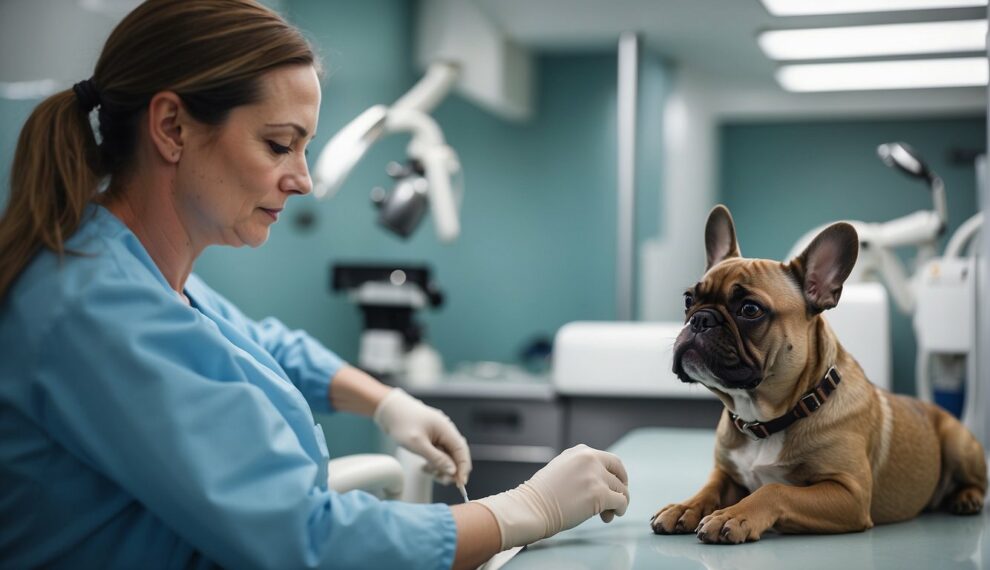Mange in dogs is a common and frustrating skin condition caused by various types of tiny mites.
Some of the most prevalent forms of this condition are sarcoptic mange, also known as scabies, and demodectic mange, referred to as red mange.
Both conditions lead to symptoms such as intense itching and skin irritation.
When I noticed my own dog scratching incessantly, it was clear something was wrong.
The realization that my furry friend was suffering from mange made me research and implement several home remedies to alleviate his discomfort.

Understanding that the mites responsible for mange thrive and multiply rapidly on a dog’s skin, I made it my mission to seek out effective strategies to combat these critters.
It wasn’t just about giving my him relief, but also ensuring that these remedies were safe for home use.
While some cases of mange certainly require veterinary intervention, especially when secondary infections are present, there are actions you can take at home to help manage mild cases.
Recognizing Symptoms and Types of Mange

Identifying Common Mange Symptoms
Before we dive in, it’s crucial for me to help you understand how to spot the pesky symptoms of mange in dogs and to distinguish between the two main types you might encounter.
When considering mange, the common signs I look out for include intense itching and noticeable hair loss.
Mites responsible for mange cause skin inflammation and irritation, leading to these symptoms.
You should also carefully check for any signs of scabies, particularly around your dog’s ears, chest, and elbows, as these areas often show early signs of infection.
Differentiating Between Sarcoptic and Demodectic Mange
Understanding the type of mange is key in combating it effectively.
Sarcoptic mange, also known as scabies, is highly contagious and is caused by the Sarcoptes scabiei mite, leading to severe itching and restlessness.
When dealing with Demodectic mange, this particular skin issue caused by Demodex canis mites, which are normally present in a dog’s skin but can cause problems if the dog’s immune system is compromised.
It’s less itchy than scabies but can lead to extensive hair loss and skin infections if not managed.
Improving Your Dog’s Immune System Can Help Prevent Mange

When dealing with mange in dogs, supporting their immune system is crucial.
A robust immune system can fight off the mites causing mange more effectively, and I’ll explore how you can strengthen your dog’s defenses through nutritional supplements and diet.
Nutritional Supplements for a Healthy Immune System In Dogs
My first focus is on supplements that can give my dog’s immune system the upper hand against mange.
Essential nutrients like Omega-3 fatty acids help reduce inflammation, which is vital when fighting skin conditions.
I also consider adding probiotics and prebiotics to my dog’s routine because a healthy gut means a stronger immune system, given that much of their immune functionality resides there.
For instance, Echinacea is a well-known herbal supplement that’s thought to enhance the immune system, although I’m always sure to check with my vet before adding any new supplements to my dog’s diet.
The Role of Diet in Treating Mange
Next, I take a close look at my dog’s diet because it’s the foundation of their overall health.
I ensure that their meals provide a balanced diet with all the necessary vitamins and minerals.
A healthy diet consists of:
- Adequate protein for tissue repair
- Healthy fats for energy and skin health
- Carbohydrates for fuel
- A range of vitamins and minerals to support the immune system
By feeding my dog with nutrient-rich foods, I support their healthy immune system, which is essential in combating mange.
I might boost their meals with foods known for immune benefits, like sweet potatoes for Vitamin A or blueberries for antioxidants.
Home Remedies for Mange Treatment

In my experience helping my own dogs with skin issues, I’ve found several natural and accessible treatments that can alleviate mange symptoms.
A proper approach combines topical applications with health-boosting remedies to tackle mange mites effectively.
Natural Oils and Their Benefits
Olive oil is not just for cooking; it can soothe and moisturize your dog’s skin, helping to alleviate irritation caused by mange.
A thin layer applied to the affected area can suffocate mange mites.
Coconut oil, with its lauric acid, has both antimicrobial and anti-inflammatory properties, making it a gentler option for sensitive skin.
Remember, too much oil can leave your dog’s coat greasy, so use sparingly.
Herbal Treatments for Skin Health
I’ve seen great benefit from using aloe vera—its cooling effect helps calm red, inflamed skin.
Simply apply pure aloe gel directly to the problem spots.
Neem oil is another herbal ingredient with natural pesticidal properties.
By diluting a few drops in a carrier oil, such as coconut oil, and applying it to the skin, you can provide relief while combating the mange mites directly.
Homemade Mange Shampoos
Mixing a homemade shampoo can help tackle mange while keeping your dog’s coat clean.
A simple shampoo recipe includes natural shampoo as a base, to which you can add apple cider vinegar—known for its skin-calming properties.
For a potent mite-fighting mix, I combine borax and hydrogen peroxide; it’s important to get the proportions right, so the pH is safe for your dog’s skin.
Lastly, for soothing relief, honey can be added for its natural antibacterial qualities.
Maintaining Hygiene and Environment

Keeping my dog’s living environment clean is critical, especially if they’re dealing with mange.
I ensure all surfaces they come into contact with are regularly cleaned and disinfected since this skin condition can be highly contagious.
Cleaning and Disinfecting Dog’s Living Space
I always start by thoroughly cleaning the area where my dog spends the most time.
This means sweeping up any hair or debris and then following up with a disinfectant that is safe for pets.
For disinfecting, I make sure to use products that are effective against mites but won’t harm my dog’s sensitive skin.
Remember to focus on areas where scabs or shedding may have occurred, as these can harbor mites.
- Daily Sweep & Mop: I sweep floors and mop with a pet-friendly disinfectant.
- Weekly Bedding Wash: Their bedding is washed weekly in hot water to kill any mites.
- Regular Surface Disinfecting: I wipe down surfaces with a disinfecting solution that’s pet-safe.
Choosing the Right Bedding
The right bedding is crucial for a dog with mange.
It should be comfortable to prevent further inflammation of the skin and easy to clean since I’ll need to wash it frequently to prevent reinfestation.
For my dog, I opt for bedding made of natural fibers that don’t irritate their already sensitive skin.
I also use hypoallergenic covers to reduce any risk of additional skin issues:
- Hypoallergenic Covers: They keep irritants away from my dog’s skin.
- Easily Washable: I choose bedding that I can toss in the washing machine on high heat.
- Replace Regularly: If bedding is too old or worn, it gets replaced to maintain a clean, mite-free environment.
When to Consult a Veterinarian
In my experience with treating mange in dogs, I’ve learned it’s crucial to know when it’s time to step back from home remedies and get professional help.
Let me share with you the signs of when it’s essential to consult a vet and what medical treatments they might recommend for severe cases.
Understanding When Home Remedies Aren’t Enough
Firstly, if my dog shows persistent signs of mange such as intense itching, hair loss, skin lesions, or scabbing, and these symptoms do not improve after a few days of home treatment, it’s time for me to consult my veterinarian.
I always look out for signs of secondary infections which can occur from constant scratching, as these can worsen my dog’s health and necessitate antibiotics, which only a vet can prescribe.
Another red flag is if my dog’s demeanor changes; if they become lethargic or lose their appetite, I don’t hesitate to make that vet appointment.
It’s better to be safe and ensure the mange isn’t indicative of a more systemic issue.
Medical Treatments for Severe Mange
When home remedies just don’t cut it, my vet might suggest more potent medical interventions.
For one, they might recommend ivermectin, an effective medicine for treating parasitic infestations.
However, I’m aware that it’s not suitable for all dog breeds, so it’s a vet’s call to use it safely.
If my dog has demodectic mange, which isn’t as contagious as other types but still troubling, my vet might use an amitraz dip.
This medication addresses the overpopulation of Demodex mites on my dog’s skin.
Importantly, because these treatments can sometimes have side effects, they should only be administered under veterinary supervision.
I always make sure to follow my vet’s instructions to the letter for my dog’s safety and the effective treatment of mange.















